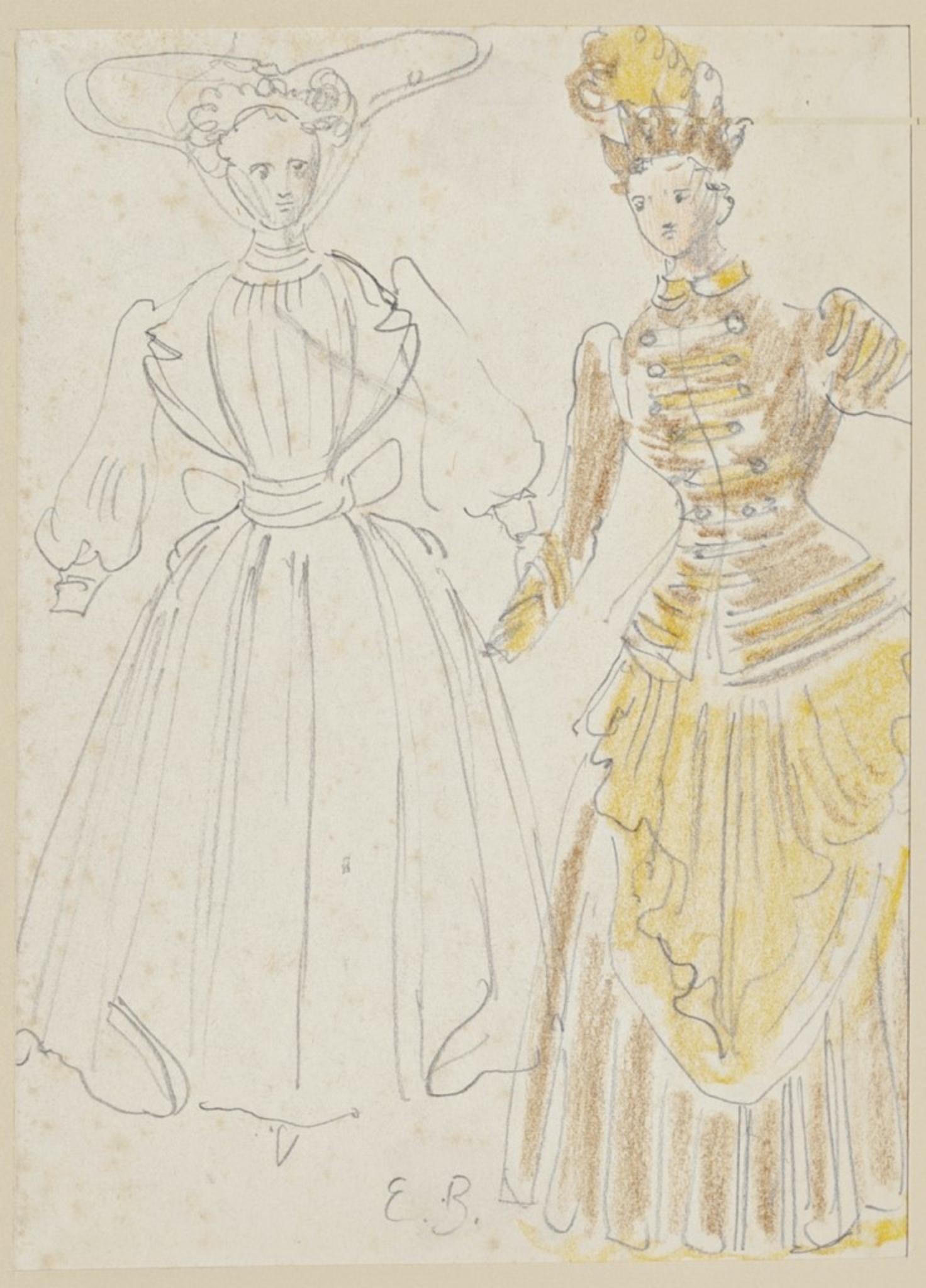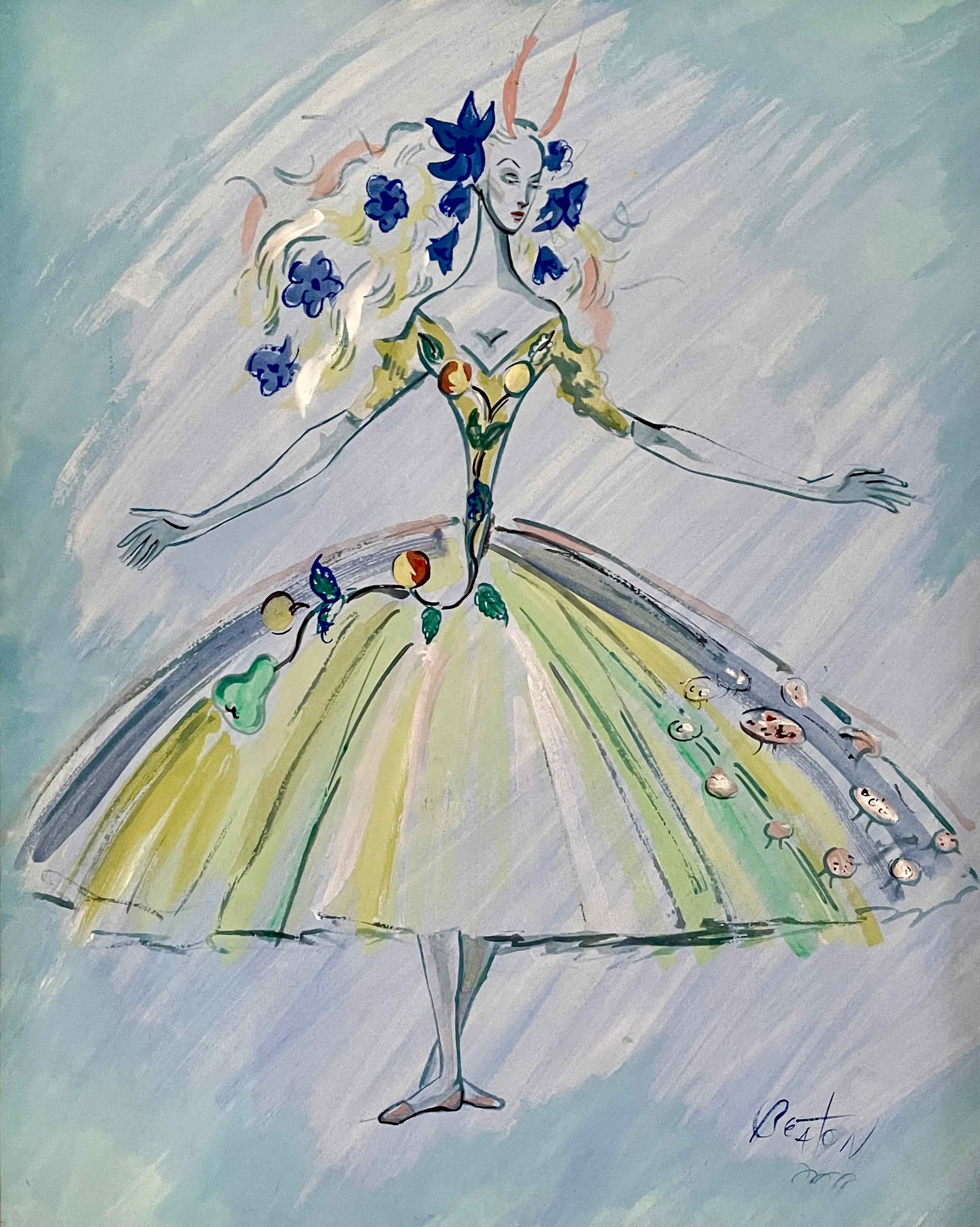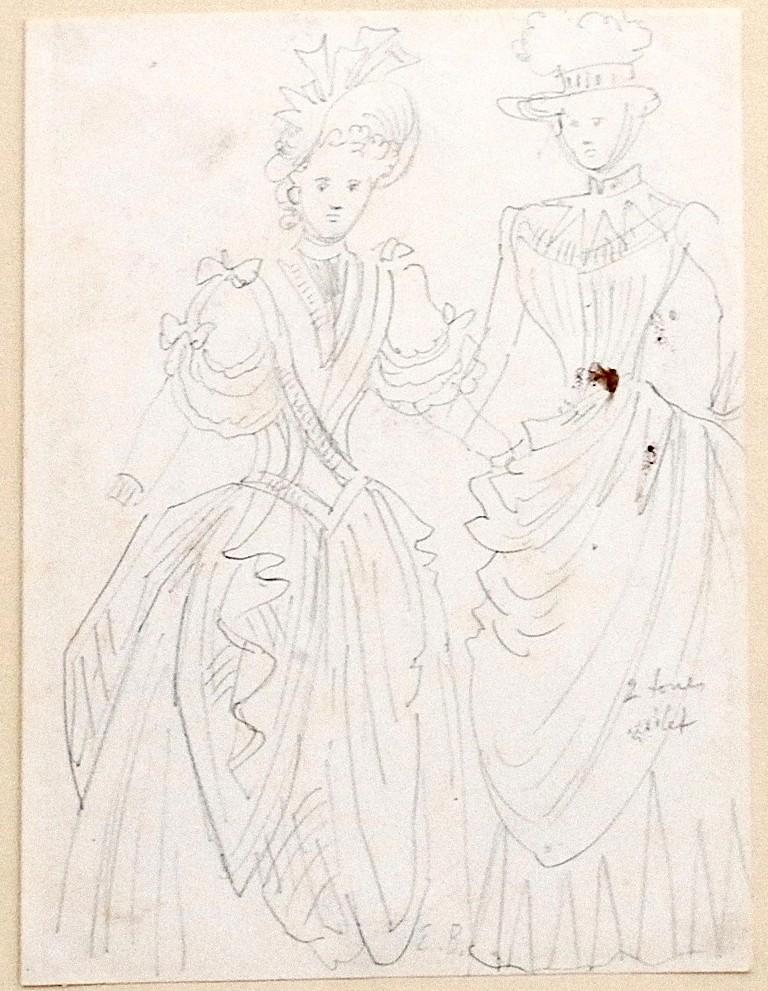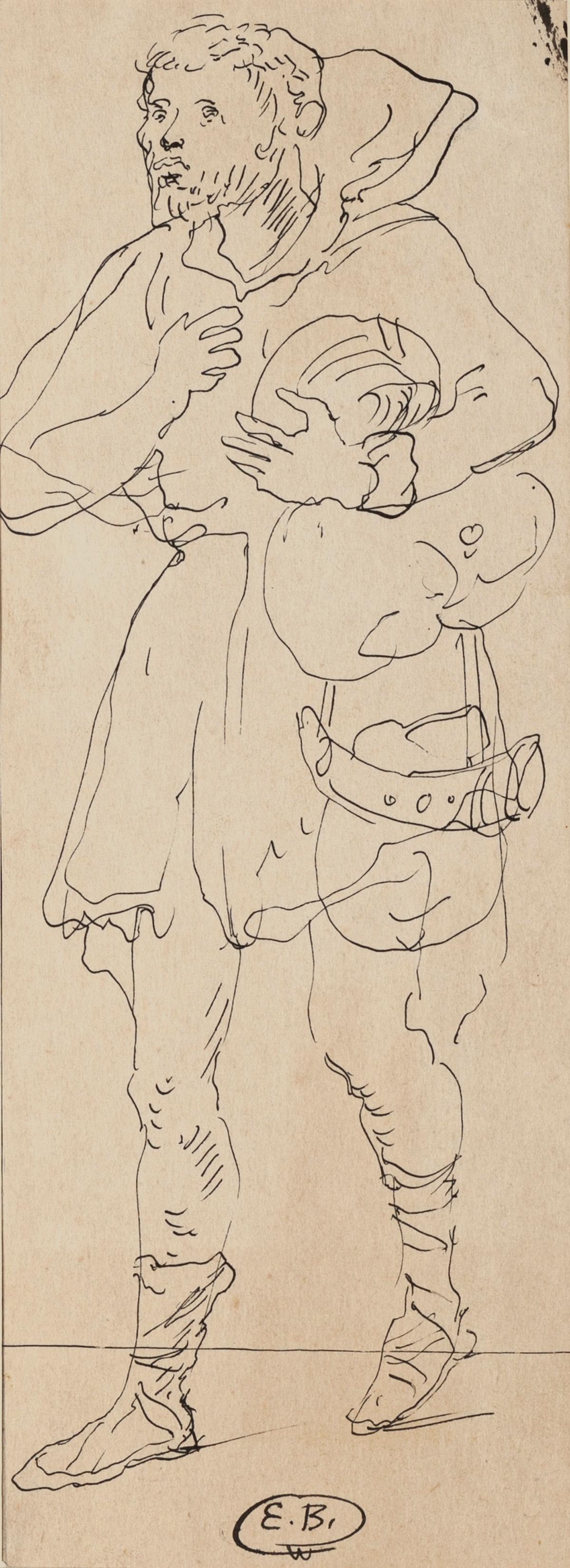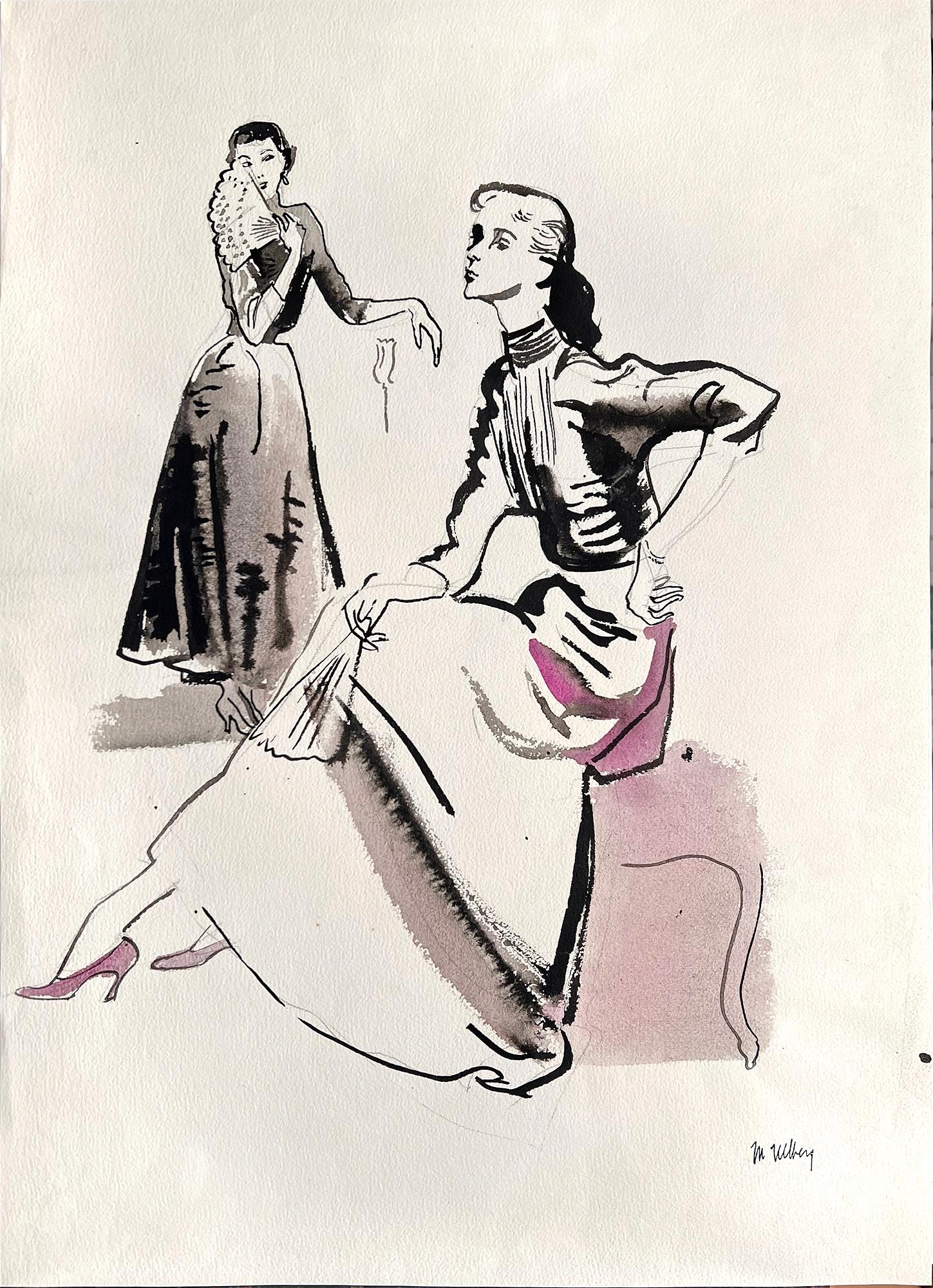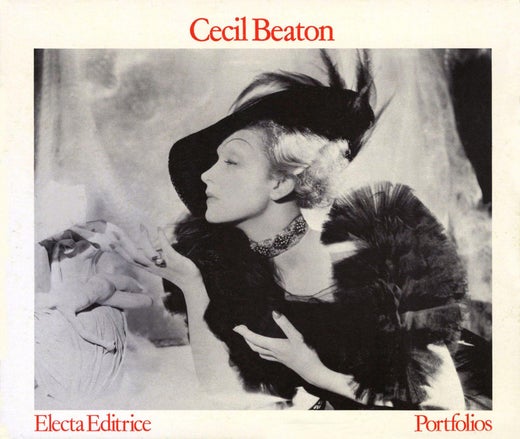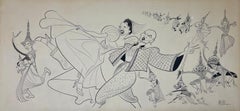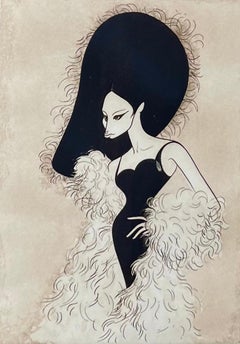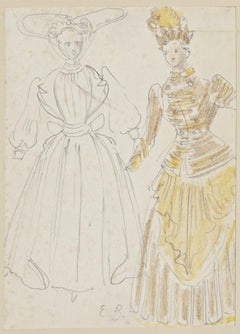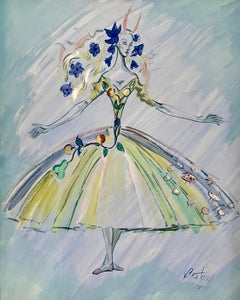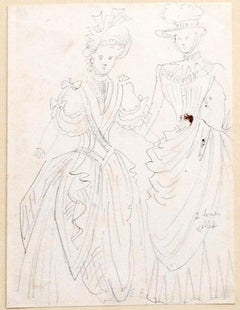"My Fair Lady" 1958 West End Theatre Costume Drawing Mid 20th Century Modern
Cecil Beaton (1904 – 1980) "My Fair Lady," Pen and ink on paper. Sight: 12 1/2 x 11 1/2 inches. Signed Beaton, lower right; inscribed My Fair Lady coster costumes, lower left. Label verso indicating that the work was in the collection of D. Maximilian Brightmore, and that it was exhibited at the Redfearn Gallery (London), June 1958.
My Fair Lady opened at the Theatre Royal Drury Lane on 30 April 1958.
The opening of Alan Jay Lerner and Frederick Loewe’s My Fair Lady at the Theatre Royal Drury Lane was one of the biggest nights in West End history.
Fresh from a triumphant run on Broadway, the show starred Rex Harrison as Professor Higgins, Julie Andrews as Eliza Doolittle and Stanley Holloway as Alfred Doolittle, with costumes by Cecil Beaton.
Rumoured to have been the most expensive production ever staged in the West End, the first night audience included Ingrid Bergman, Dirk Bogarde and Terence Rattigan.
The BBC said at the time that black-market tickets were selling for as much as £5 – almost five times their original price.
BIO
Sir Cecil Walter Beaton was an English fashion and portrait photographer, diarist, style icon, interior designer and an Academy Award-winning stage and costume designer for films and the theatre.
He was born on January 14, 1904 in Hampstead the son of Ernest Walter Hardy Beaton (1867-1936), a prosperous timber merchant, and his wife Etty Sissons (1872-1962). His grandfather, Walter Hardy Beaton (1841-1904) had founded the family business of Beaton Brothers Timber Merchants and Agents, and his father followed into the business. Ernest Beaton was also an amateur actor and had met his wife, Cecil's mother, when playing the lead in a play. She was the daughter of a Cumbrian blacksmith who had come to London to visit her married sister. They had four children - in addition to Cecil there were two daughters Nancy (1909-1999) and Baba (1912-1973), and another son Reggie (1905-1933).
Cecil Beaton was educated at Heath Mount School (where he was bullied by Evelyn Waugh) and St Cyprian's School, Eastbourne, where his artistic talent was quickly recognised. Both Cyril Connolly and Henry Longhurst report in their autobiographies of being overwhelmed by the beauty of Beaton's singing at the St Cyprian's school concerts.
When Beaton was growing up his Nanny had a Kodak 3A Camera, a popular model, which was renowned for being an ideal piece of equipment to learn on. Beaton's nanny began teaching him the basics of photography and developing film. He would often get his sisters and mother to sit for him. When he was sufficiently proficient, he would send the photos off to London society magazines, often writing under a pen name and 'recommending' the work of Beaton.
Beaton went on to Harrow, and then, despite having little or no interest in academia, moved on to St John's College, Cambridge, and studied history, art and architecture. Beaton continued his photography, and through his university contacts managed to get a portrait sitting with the Duchess of Malfi — actually George "Dadie" Rylands, and as Beaton recalled years later: "It was a slightly out-of-focus snapshot of him as Webster's Duchess of Malfi standing in the sub-aqueous light outside the men's lavatory of the ADC Theatre at Cambridge." The resulting images gave Beaton his first ever piece of published work when Vogue magazine bought and printed the photos.
Beaton left Cambridge without a degree in 1925, but only coped with salaried employment in his father's timber business for eight days. His brother Reggie, however, entered the business and remained until his death in October 1933. For fifteen years between 1930 and 1945, Beaton leased Ashcombe House in Wiltshire, where he entertained many notable figures.
Beaton designed book jackets and costumes for charity matinees, learning the professional craft of photography at the studio of Paul Tanqueray, until Vogue took him on regularly in 1927. He also set up his own studio, and one of his earliest clients and, later, best friends was Stephen Tennant; Beaton's photographs of Tennant and his circle are considered some of the best representations of the Bright Young People of the twenties and thirties.
He was a photographer for the British edition of Vogue in 1931 when George Hoyningen-Huene, photographer for the French Vogue traveled to England with his new friend Horst. Horst himself would begin to work for French Vogue in November of that year. The exchange and cross pollination of ideas between this collegial circle of artists across the Channel and the Atlantic gave rise to the look of style and sophistication for which the 1930s are known.
Beaton is best known for his fashion photographs and society portraits. He worked as a staff photographer for Vanity Fair and Vogue in addition to photographing celebrities in Hollywood.
Beaton's first camera was a Kodak 3A folding camera. Over the course of his career, he employed both large format cameras, and smaller Rolleiflex cameras. Beaton was never known as a highly skilled technical photographer, and instead focused on staging a compelling model or scene and looking for the perfect shutter-release moment.
Beaton often photographed the Royal Family for official publication. Queen Elizabeth, the Queen Mother, was his favourite Royal sitter, and he once pocketed her scented hankie as a keepsake from a highly successful shoot. Beaton took the famous wedding pictures of the Duke and Duchess of Windsor (wearing an ensemble by the noted fashion designer Mainbocher).
During the Second World War, Beaton was initially posted to the Ministry of Information and given the task of recording images from the home front. During this assignment he captured one of the most enduring images of British suffering during the war, that of three-year-old Blitz victim Eileen Dunne recovering in hospital, clutching her beloved teddy bear. When the image was published, America had not yet officially joined the war—but splashed across the press in the US, images such as Beaton's helped push the American public to put pressure on their Government to help Britain in its hour of need.
Beaton had a major influence on and relationship with two other leading lights in British photography, that of Angus McBean and David Bailey. McBean was arguably the best portrait photographer of his era—in the second part of McBean's career (post-war) his work is clearly heavily influenced by Beaton, though arguably McBean was technically far more proficient in his execution. Bailey was also enormously influenced by Beaton when they met while working for British Vogue in the early 1960s, Bailey's stark use of square format (6x6) images bears clear connections to Beaton's own working patterns.
After the war, Beaton tackled the Broadway stage, designing sets, costumes, and lighting for a 1946 revival of Lady Windermere's Fan, in which he also acted. His most lauded achievement for the stage was the costumes for Lerner and Loewe's My Fair Lady (1956), which led to two Lerner and Loewe film musicals, Gigi (1958) and My Fair Lady (1964), both of which earned Beaton the Academy Award for Costume Design. He also designed the period costumes for the 1970 film On a Clear Day You Can See Forever.
Additional Broadway credits include The Grass Harp (1952), The Chalk Garden (1955), Saratoga (1959), Tenderloin (1960), and Coco (1969). He is the winner of four Tony Awards.
He also designed the sets and costumes for a production of Puccini's last opera Turandot, first used at the Metropolitan Opera in New York and then at Covent Garden.
He also designed the academic dress of the University of East Anglia.[8]
Cecil Beaton was also a published and well-known diarist. In his lifetime six volumes of diaries were published, spanning the years 1922-1974. Recently a number of unexpurgated diaries have been published. These differ immensely in places to Beaton's original publications. Fearing libel suits in his own lifetime, it would have been foolhardy for Beaton to have included some of his more frank and incisive observations.
In 1972, he was knighted. Two years later he suffered a stroke that would leave him permanently paralysed on the right side of his body. Although he learnt to write and draw with his left hand, and had cameras adapted, Beaton became frustrated by the limitations the stroke had put upon his work. As a result of his stroke, Beaton became anxious about financial security for his old age and, in 1976, entered into negotiations with Philippe Garner, expert-in-charge of photographs at Sotheby's. On behalf of the auction house, Garner acquired Beaton's archive—excluding all portraits of the Royal Family, and the five decades of prints held by Vogue in London, Paris and New York. Garner, who had almost singlehandedly invented the photographic auction, oversaw the archive's preservation and partial dispersal, so that Beaton's only tangible assets, and what he considered his life's work, would ensure him an annual income. The first of five auctions was held in 1977, the last in 1980.
By the end of the 1970s, Beaton's health had faded to that of an old man. In January 1980, he died during the night at Reddish House, his home in Broad Chalke in Wiltshire, at the age of 76.
The great love of his life was the art collector Peter Watson, although they were never lovers. He had relationships with various men, and claimed to have had an affair with the American actor Gary Cooper, who was a close friend of his for many years. He also had relationships with women, including the actresses Greta Garbo and Coral Browne, and the British socialite Doris, Viscountess Castlerosse.
